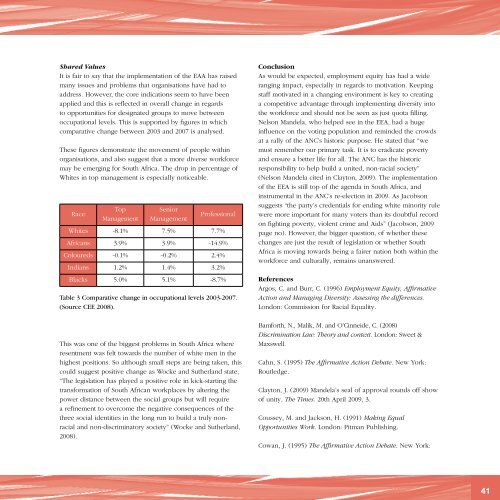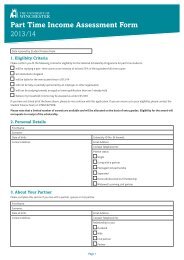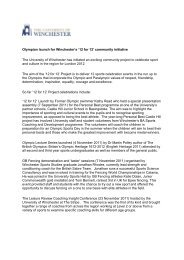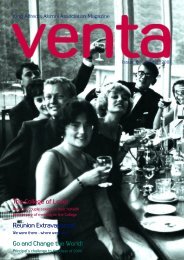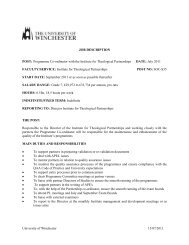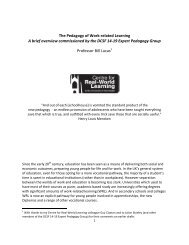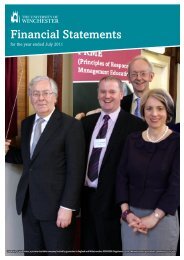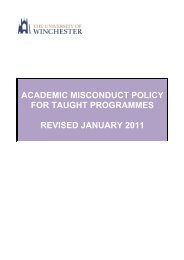alfred 2 - University of Winchester
alfred 2 - University of Winchester
alfred 2 - University of Winchester
You also want an ePaper? Increase the reach of your titles
YUMPU automatically turns print PDFs into web optimized ePapers that Google loves.
Shared Values<br />
It is fair to say that the implementation <strong>of</strong> the EAA has raised<br />
many issues and problems that organisations have had to<br />
address. However, the core indications seem to have been<br />
applied and this is reflected in overall change in regards<br />
to opportunities for designated groups to move between<br />
occupational levels. This is supported by figures in which<br />
comparative change between 2003 and 2007 is analysed.<br />
These figures demonstrate the movement <strong>of</strong> people within<br />
organisations, and also suggest that a more diverse workforce<br />
may be emerging for South Africa. The drop in percentage <strong>of</strong><br />
Whites in top management is especially noticeable.<br />
Race<br />
Top<br />
Management<br />
Senior<br />
Management<br />
Pr<strong>of</strong>essional<br />
Whites -8.1% 7.5% 7.7%<br />
Africans 3.9% 3.9% -14.9%<br />
Coloureds -0.1% -0.2% 2.4%<br />
Indians 1.2% 1.4% 3.2%<br />
Blacks 5.0% 5.1% -8.7%<br />
Table 3 Comparative change in occupational levels 2003-2007.<br />
(Source CEE 2008).<br />
This was one <strong>of</strong> the biggest problems in South Africa where<br />
resentment was felt towards the number <strong>of</strong> white men in the<br />
highest positions. So although small steps are being taken, this<br />
could suggest positive change as Wocke and Sutherland state,<br />
“The legislation has played a positive role in kick-starting the<br />
transformation <strong>of</strong> South African workplaces by altering the<br />
power distance between the social groups but will require<br />
a refinement to overcome the negative consequences <strong>of</strong> the<br />
three social identities in the long run to build a truly nonracial<br />
and non-discriminatory society” (Wocke and Sutherland,<br />
2008).<br />
Conclusion<br />
As would be expected, employment equity has had a wide<br />
ranging impact, especially in regards to motivation. Keeping<br />
staff motivated in a changing environment is key to creating<br />
a competitive advantage through implementing diversity into<br />
the workforce and should not be seen as just quota filling.<br />
Nelson Mandela, who helped see in the EEA, had a huge<br />
influence on the voting population and reminded the crowds<br />
at a rally <strong>of</strong> the ANC’s historic purpose. He stated that “we<br />
must remember our primary task. It is to eradicate poverty<br />
and ensure a better life for all. The ANC has the historic<br />
responsibility to help build a united, non-racial society”<br />
(Nelson Mandela cited in Clayton, 2009). The implementation<br />
<strong>of</strong> the EEA is still top <strong>of</strong> the agenda in South Africa, and<br />
instrumental in the ANC’s re-election in 2009. As Jacobson<br />
suggests “the party’s credentials for ending white minority rule<br />
were more important for many voters than its doubtful record<br />
on fighting poverty, violent crime and Aids” (Jacobson, 2009<br />
page no). However, the bigger question, <strong>of</strong> whether these<br />
changes are just the result <strong>of</strong> legislation or whether South<br />
Africa is moving towards being a fairer nation both within the<br />
workforce and culturally, remains unanswered.<br />
References<br />
Argos, C. and Burr, C. (1996) Employment Equity, Affirmative<br />
Action and Managing Diversity: Assessing the differences.<br />
London: Commission for Racial Equality.<br />
Bamforth, N., Malik, M. and O’Cinneide, C. (2008)<br />
Discrimination Law: Theory and context. London: Sweet &<br />
Maxswell.<br />
Cahn, S. (1995) The Affirmative Action Debate. New York:<br />
Routledge.<br />
Clayton, J. (2009) Mandela’s seal <strong>of</strong> approval rounds <strong>of</strong>f show<br />
<strong>of</strong> unity. The Times. 20th April 2009, 3.<br />
Coussey, M. and Jackson, H. (1991) Making Equal<br />
Opportunities Work. London: Pitman Publishing.<br />
Cowan, J. (1995) The Affirmative Action Debate. New York:<br />
41


